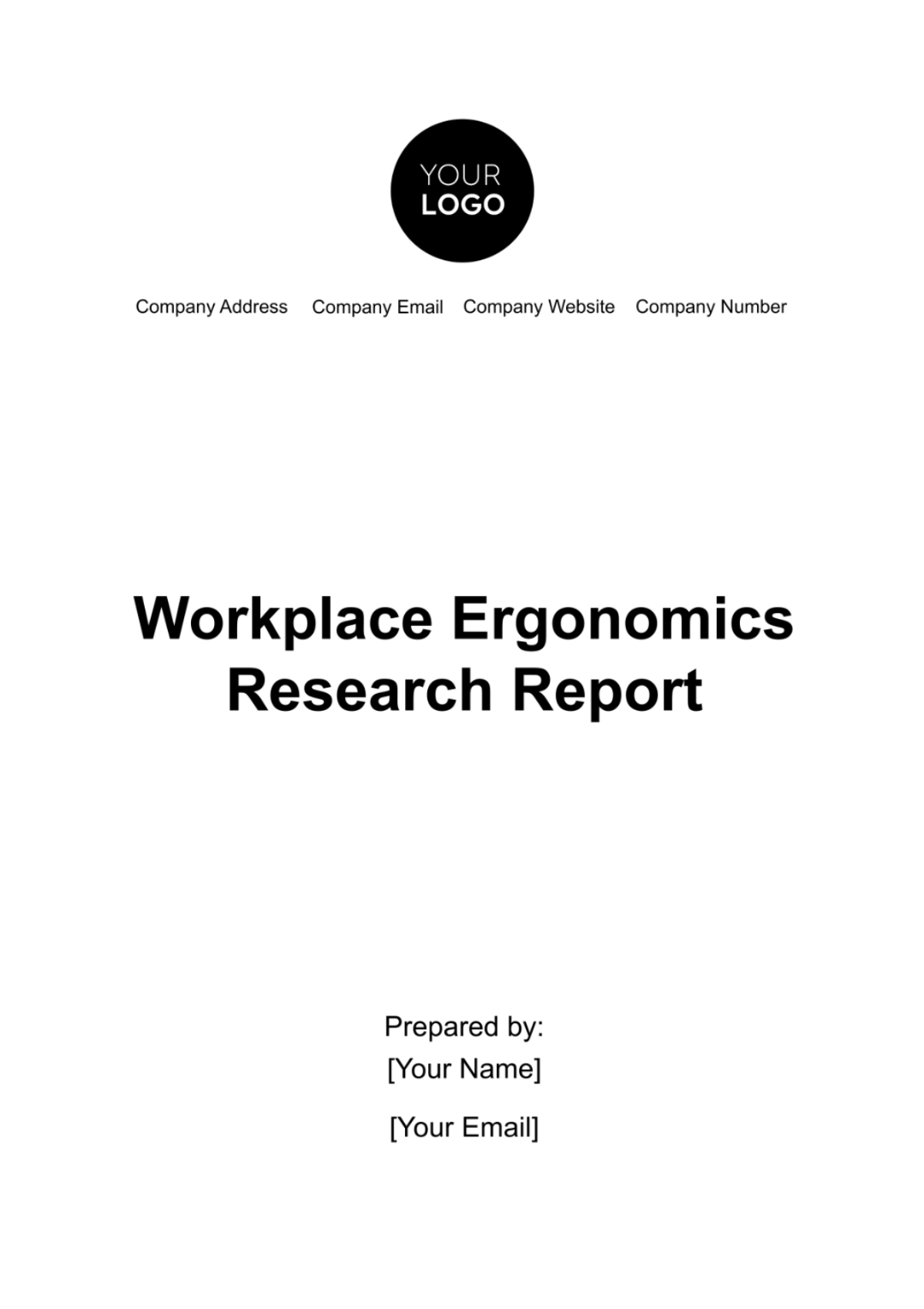Free Workplace Ergonomics Research Report

I. INTRODUCTION
This research report has been compiled to provide an in-depth analysis of the current state of workplace ergonomics at [Your Company Name]. Recognizing the critical importance of ergonomic practices in ensuring employee well-being and productivity, this report aims to assess our existing ergonomic environment, identify areas for improvement, and propose actionable strategies to enhance the ergonomic standards in our workplace.
II. BACKGROUND
The concept of ergonomics, or the study of people's efficiency in their working environment, has gained significant importance in the modern workplace. As [Your Company Name] continues to evolve and grow, it becomes imperative to ensure that our workplace design and practices do not adversely affect our employees' physical health, particularly concerning musculoskeletal disorders (MSDs) which are prevalent in office settings.
This report is grounded in the understanding that a well-designed ergonomic workspace can lead to reduced absenteeism, lower healthcare costs, increased productivity, and improved employee morale.
III. METHODOLOGY
A. Ergonomic Risk Assessment
A comprehensive ergonomic risk assessment was conducted across various departments of [Your Company Name]. This assessment involved an evaluation of workstation setups, the physical layout of the workplace, and the nature of work tasks. Tools such as the REBA (Rapid Entire Body Assessment) and RULA (Rapid Upper Limb Assessment) were employed to systematically identify potential ergonomic risks.
B. Employee Surveys and Interviews
Surveys were distributed to employees to gather subjective data on their experiences with workplace ergonomics, any physical discomfort experienced, and their own suggestions for improvements. In-depth interviews and focus group discussions were also conducted to gain a more nuanced understanding of individual and departmental ergonomic concerns.
C. Review of Workplace Injury Records
An analysis of historical injury records was undertaken to identify trends and patterns in work-related injuries that might be attributable to poor ergonomic practices.
IV. FINDINGS
1. Assessment Findings | The ergonomic risk assessments revealed several areas of concern, particularly in the administration and IT departments. Issues such as improper chair height, inadequately positioned monitors, and poor desk setup were commonplace. |
2. Employee Feedback | The survey responses highlighted widespread discomfort among employees, with a significant portion reporting regular discomfort in the neck, back, and wrists. Many employees expressed a lack of awareness of ergonomic best practices and a desire for more ergonomic furniture and equipment. |
3. Injury Record Analysis | The analysis of workplace injury records indicated a higher incidence of MSDs compared to industry benchmarks. Recurring themes in these records included back pain, wrist strain, and shoulder discomfort. |
V. ANALYSIS
The analysis of this data reveals several critical areas that require immediate attention, as well as underlying factors contributing to ergonomic issues.
A. Ergonomic Risk Factors Identified
The ergonomic risk assessments highlighted multiple risk factors prevalent in our current workplace setup. These include poorly designed workstations leading to awkward postures, repetitive tasks contributing to strain injuries, and inadequate equipment exacerbating the risk of MSDs. Particularly in departments like administration and IT, where employees spend prolonged periods at their desks, the risk of ergonomic injuries is significantly heightened.
B. Impact of Poor Ergonomics on Employee Health
Employee surveys and injury records indicate a direct correlation between inadequate ergonomic practices and the prevalence of MSDs among employees. Common complaints include back pain, neck strain, and wrist discomfort, which not only affect the employees' immediate health and comfort but also contribute to longer-term health issues. These health concerns are leading to increased absenteeism and a noticeable decline in productivity and employee morale.
C. Employee Awareness and Behavior
A concerning finding from the employee surveys is the general lack of awareness about ergonomic best practices. Many employees are unaware of the correct posture to maintain while working or how to properly adjust their workstations. This lack of knowledge underscores the need for comprehensive ergonomic training and ongoing education initiatives.
D. Organizational Culture and Ergonomics
The analysis also sheds light on the organizational culture surrounding workplace ergonomics at [Your Company Name]. Currently, there appears to be a gap in how ergonomic principles are integrated into daily work routines and how employees perceive the importance of ergonomics. This highlights the need for a cultural shift towards prioritizing ergonomics as a key component of employee well-being and workplace safety.
E. Comparison with Industry Standards
Compared to ergonomic benchmarks and best practices in our industry, [Your Company Name] is currently falling short in several areas. This is particularly evident in workstation design and the provision of ergonomic tools and equipment. Aligning with these industry standards should be a priority to ensure the health and safety of our employees.
F. Potential for Improvement
Despite the challenges, there is significant potential for improvement. The data suggests that with targeted interventions, particularly in workstation redesign and employee training, considerable progress can be made in enhancing our workplace ergonomics. These changes are not only necessary for employee well-being but are also likely to lead to improved efficiency and productivity.
VI. RECOMMENDATIONS
Based on the findings and analysis, the following recommendations are proposed to improve the ergonomic conditions at [Your Company Name]:
A. Workstation Redesign
Redesign workstations to comply with ergonomic standards. This includes adjusting desk heights, providing ergonomic chairs, and ensuring that computer monitors are at eye level to prevent neck strain.
Implement the use of adjustable equipment like sit-stand desks, ergonomic keyboards, and mice to cater to the varying needs of employees.
B. Ergonomic Training and Education
Develop a comprehensive ergonomic training program for all employees, focusing on the importance of proper posture, correct use of ergonomic tools, and techniques to reduce physical strain.
Include specific training modules for different departments, addressing unique ergonomic challenges faced by each.
C. Regular Ergonomic Assessments
Establish a schedule for regular ergonomic assessments to identify new risks or areas needing improvement.
Use a standardized assessment tool to ensure consistency in evaluations.
D. Employee Wellness Programs
Introduce wellness programs that include activities such as stretching exercises, yoga sessions, and health workshops to promote overall physical well-being.
E. Feedback Mechanism
Implement a system for employees to provide ongoing feedback about ergonomic issues and suggestions for improvements.
Table 1: Ergonomic Improvement Plan
Area of Focus | Action Item | Implementation Timeline |
Workstation Redesign | Adjustable Desks and Chairs | Q2 [Year] |
Training and Education | Ergonomic Awareness Workshops | Q3 [Year] |
Assessment | Biannual Ergonomic Assessments | Q4 [Year], Q2 [Year]+1 |
Wellness Programs | Weekly Stretching and Yoga Sessions | Q1 [Year] +1 |
VII. IMPLEMENTATION STRATEGY
To ensure the effective implementation of these recommendations, a detailed strategy is laid out as follows:
A. Resource Allocation
Allocate necessary resources, including budget and personnel, for the implementation of ergonomic improvements and training programs.
B. Phased Implementation
Prioritize implementation based on the urgency and impact of ergonomic issues. Start with quick wins like workstation adjustments before moving to more comprehensive changes.
C. Collaboration with Ergonomic Experts
Partner with ergonomic consultants for specialized guidance in workstation redesign and training program development.
D. Employee Involvement
Involve employees in the implementation process, particularly in testing new equipment and providing feedback.
E. Monitoring and Adjustment
Continuously monitor the effectiveness of implemented changes and make adjustments as needed.
VIII. EVALUATION AND CONTINUOUS IMPROVEMENT
An ongoing evaluation process is crucial to ensure the long-term success and relevance of ergonomic interventions.
1. Post-Implementation Review | Conduct a review after each phase of implementation to assess the impact of changes and identify areas for further improvement. |
2. Employee Surveys and Feedback | Regularly conduct surveys and collect employee feedback to gauge the effectiveness of ergonomic changes and training programs. |
3. Injury and Absenteeism Tracking | Monitor trends in workplace injuries and absenteeism rates as indicators of the effectiveness of ergonomic interventions. |
4. Continuous Improvement Process | Adopt a continuous improvement approach, using feedback and data to refine and enhance ergonomic practices |
IX. CONCLUSION
The Workplace Ergonomics Research Report for [Your Company Name] highlights the critical need for ergonomic improvements within our organization. By following the recommended actions and implementation strategies, we can significantly enhance the work environment, leading to improved employee well-being, reduced injury rates, and increased productivity. This report serves as a roadmap for our journey towards creating an ergonomically sound workplace, ensuring the health and efficiency of our team are maintained at the highest standards.
- 100% Customizable, free editor
- Access 1 Million+ Templates, photo’s & graphics
- Download or share as a template
- Click and replace photos, graphics, text, backgrounds
- Resize, crop, AI write & more
- Access advanced editor
Introducing the Workplace Ergonomics Research Report Template from Template.net. Crafted to streamline your findings, this editable and customizable template offers unparalleled convenience. Utilize our Ai Editor Tool to effortlessly tailor your report, ensuring clarity and professionalism. Elevate your workplace research with this essential tool today.
You may also like
- Sales Report
- Daily Report
- Project Report
- Business Report
- Weekly Report
- Incident Report
- Annual Report
- Report Layout
- Report Design
- Progress Report
- Marketing Report
- Company Report
- Monthly Report
- Audit Report
- Status Report
- School Report
- Reports Hr
- Management Report
- Project Status Report
- Handover Report
- Health And Safety Report
- Restaurant Report
- Construction Report
- Research Report
- Evaluation Report
- Investigation Report
- Employee Report
- Advertising Report
- Weekly Status Report
- Project Management Report
- Finance Report
- Service Report
- Technical Report
- Meeting Report
- Quarterly Report
- Inspection Report
- Medical Report
- Test Report
- Summary Report
- Inventory Report
- Valuation Report
- Operations Report
- Payroll Report
- Training Report
- Job Report
- Case Report
- Performance Report
- Board Report
- Internal Audit Report
- Student Report
- Monthly Management Report
- Small Business Report
- Accident Report
- Call Center Report
- Activity Report
- IT and Software Report
- Internship Report
- Visit Report
- Product Report
- Book Report
- Property Report
- Recruitment Report
- University Report
- Event Report
- SEO Report
- Conference Report
- Narrative Report
- Nursing Home Report
- Preschool Report
- Call Report
- Customer Report
- Employee Incident Report
- Accomplishment Report
- Social Media Report
- Work From Home Report
- Security Report
- Damage Report
- Quality Report
- Internal Report
- Nurse Report
- Real Estate Report
- Hotel Report
- Equipment Report
- Credit Report
- Field Report
- Non Profit Report
- Maintenance Report
- News Report
- Survey Report
- Executive Report
- Law Firm Report
- Advertising Agency Report
- Interior Design Report
- Travel Agency Report
- Stock Report
- Salon Report
- Bug Report
- Workplace Report
- Action Report
- Investor Report
- Cleaning Services Report
- Consulting Report
- Freelancer Report
- Site Visit Report
- Trip Report
- Classroom Observation Report
- Vehicle Report
- Final Report
- Software Report





























